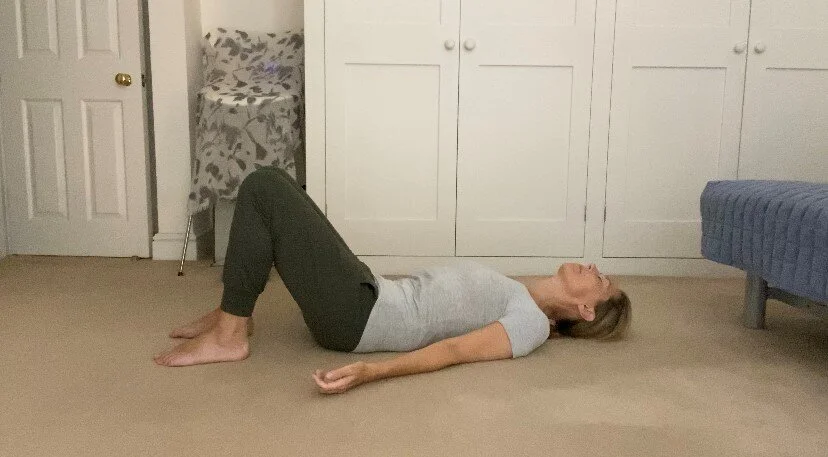Clinical Somatic Education
Welcome to this Somatics Foundation Course. I would like to walk you through the principles of this course;
Reconnect with your body
Awareness of your posture
Awareness of how your habits impact your posture
Importance of conscious breathing
Clinical Somatics Education
Reconnect with your body
To keep up with the speed of modern life, we have started to live more from our heads – we are constantly in thinking mode, disconnected from our body and feeling. We have lost trust in the intuitive knowing of our bodies. We forget that so much of our life’s intellegence is done without our minds consciously involved (heartbeat, blood flow, breathing, immune response etc.). Some peopple only start to really feel their body when it sends signals of pain. Reconnecting with the signals your body sends you can help you improve your posture, release tension, lessen pain and feel better overall. When we slow down and tune into our internal senses – interoception.
Awareness of posture
Awareness is observing yourself without judgement, but with openness, curiosity and kindness. This takes practice as we are hardwired to judge, fix and compare. It’s an innate survival mechanism to keep us safe. But when we practice we need to trust we are in a safe space, we can close our eyes and really tune into sensations and create a genuine awareness of how we are feeling. We practice standing awareness at the start and end of every practice to also notice the impact of the practice.
Awareness of how your habits impact your posture
With this awareness we can start noticing subtle imbalances in our bodies. We can start connecting these imbalances with habits (for instance shoulder over one shoulder, crossing legs habitual way, rounding over a desk, etc.). With the somatic exercises we start to release the muscular imbalances, and in daily life we become more aware of when we are going into habit, and then change the habit, uncross the legs, use the other shoulder (or a backpack), sit a little straighter.
Importance of conscious breathing
Breathing is something we do all day every day without having to think about it. However we can control our breath; conscious breathing is when we control our breath. It is a powerful exercise as we can quickly and profoundly impact our nervous system; for instance with deep belly breathing we trigger the parasympathetic side of the nervous system, or the rest and digest system which means we are not stressed but relaxed. Every practice, once we have done the standing awareness, we connect with deep belly breathing. We try to keep this relaxed way of breathing all through the practice, so we can have maximum impact releasing muscle tension (it’s impossible to release tension when we are stressed) and our brain is in the best state to learn and be reprogrammed.
Clinical Somatics Education
Now to the crux of it; Somatics and what is it? The word somatic means “of or relating to the living body,” and it has long been used in medical terminology like somatic cell, somatic nervous system, somatic disorder, and somatic pain. Due to its generic definition, the term somatic can be used to describe a variety of forms of movement and healing modalities.
“Clinical Somatics retrains the nervous system to release involuntary muscle tension and relieve pain by retraining damaging posture and movement patterns.” Let’s unpack this as there is a lot here!
When we are born we need to learn how to sit and move. To be more precise, we need to teach our brain which muscles to engage and subsequently release to make certain movements. These movement patterns are stored in the sensory-motor cortex of the brain. When a muscle needs to be engaged (contracted) a signal is generated in the nervous system, and when this muscle no longer needs to be engaged, the signal stops (there is no release signal).
The way we habitually cross our legs, wear handbags, sit behind a desk, etc., will also create movement patterns. If for instance, we always wear our bag over our right shoulder, that right shoulder might become slightly elevated over time, as it stops the bag from slipping. If we wear the bag often, our right shoulder might stay permanently lifted as our brain thinks this is our preferred way of being. Our brain reprograms the neutral position of the shoulder in order to aid a movement we often make; it ensures to keeps certain muscles slightly engaged to aid the automatic lift of our shoulder. This process of reprogramming and ‘forgetting’ the neutral position is called Sensory Motor Amnesia (SMA).
Another example might be that we habitually sit slightly hunched at our desk; this is far from our ‘neutral position’; our jaw contracts, our shoulders lift up, our head comes forward, our eyes and brow contract, our elbows bend, our arms rotate inward, our abdominals contract, our inner thigh muscles and hamstrings tighten, and our knees and ankles roll inward. That is a lot of habitual muscle engagement if you sit at a desk for a long time.
Stretching muscles might temporarily feel like relief, but as the programmed section of the brain will keep the muscles contracted, before long the muscles will feel tight again. So the only way to permanently release the tension is to retrain the brain to know what the actual neutral position is. That is what Clinical Somatic Education does; it slowly reprograms our brain to create good posture.
It does this with slow, purposeful movements, reminding your brain what is the neutral position of your muscles and with pandiculation. Pandiculation results in lasting release of involuntary muscular contraction because it retrains the nervous system, resetting the resting level of muscle tension. Pandiculation gently contracts muscles and then very slowly releases them.
These slow, mindful movements, the conscious breathing have a powerful effect on your physical and mental health. Just 15-30 minutes a day have a long lasting impact on your posture and wellbeing.
We notice it most through our Standing Awareness, a practice we do at the start and end of every practice. We practice proprioception, the sense of oneself within, the sense that provides feedback to and from our muscles to our central nervous system. Proprioception involves the efferent nerves going to (motor neurons) and coming afferent nerves from (sensory neurons) muscle fibres to regulate tone and tension. The standing awareness practice makes us aware of imbalances in our standing position; we learn to feel if the weight is to the front or back, whether we lean one way or another, whether a hip or shoulder is further to the front or side, etc. We learn to feel where there is tension around our spine and more importantly how a practice can release this tension and that with the absence of tension our posture improves. As long as the cause of the imbalance is habitual (and not structural) we can improve this and feel better.
Clinical Somatic Education recognises three reflexes which can cause postural issues; the Green Light, Red Light and Trauma Reflexes. People can have aspects of all three in their posture.
The Green Light Reflex is the reflex involved in forward movement. All of the large muscles of the back contract to move you forward in walking, running and standing. The back muscles can learn to stay overly-contracted, pulling the back into an exaggerated arch. You can think of this reflex as an arching reflex, like a soldier at attention. When running for the train, sitting at the computer for many hours, picking up a child, or standing all day long, these "green light" muscles are working to help you "get the job done." If this reflexive response to stress becomes habituated, conditions such as herniated disks, neck pain, shoulder pain, and sciatica can develop.
The Red Light Reflex, more commonly known as the Startle Response, involves the muscles on the front of the body, which tighten to pull you forward. This "slumping reflex" presents itself with rounded shoulders, depressed chest and the head jutting forward. It is a protective reflex found in all vertebrate animals and is a response to fear, anxiety, prolonged distress or negativity. A loud noise, unexpected sound or emotional trauma (or long hours hunched over the computer) can cause the muscles of the front of the body to contract suddenly as the body pulls inward in a slumping posture. An habituated Red Light Reflex can lead to chronic neck pain, jaw pain (as with TMJ), a “widow’s hump," hip pain, mid-back pain and shallow breathing. The inability to breathe deeply deprives your brain, blood and muscles of the oxygen they need to function properly. This in turn can cause fatigue, depression, anxiety, sleep problems and exacerbate allergies.
The Trauma Reflex occurs involuntarily in response to accidents and injuries and the need to avoid further pain as one compensates due to an injury. This reflex involves the muscles of the trunk rotators, which, when contracted, hike the hip on one side and twist the spine slightly. Examples of this would be the repetitive task of holding a young child on one’s hip, a sudden fall of any kind, limping on one side in response to, for example, a twisted ankle on the other side, falling on one’s tailbone in a fall or suffering from appendicitis. This reflex presents with side bending and rotations in the pelvis/trunk/shoulder/head. This postural compensation may be slight, or very noticeable, but its effects can be devastating. In many cases scoliosis is an example of an habituated trauma reflex, creating a curve and tilting in the spine and trunk.
Habitual trauma (emotional, work stress, being scared...) can also cause the body to develop SMA in one or a combination of these reflexes.
Unfortunately, due to Sensory Motor Amnesia, some people stay stuck in the extremes of these postural reflexes out of habit, unable to sense the postural imbalances in their bodies. Many medical professional see these problems as structural in nature, when in fact they are functional. Improved function of the muscles improves the structure (posture). In practice, Clinical Somatic Education resolves these problems through a process of cultivating awareness of the “amnesic” muscles first, then retraining the brain to retrain the muscles to release and relax back to a new length. This process results in improved balance, coordination and overall functioning of the musculoskeletal system. Ultimately one becomes more self-aware, self-monitoring, self-regulating and self-healing.
Sensory-motor awareness can be improved infinitely with practice. Students should be strongly encouraged to practice the standing awareness exercise on a regular basis, even after they have been doing Clinical Somatics exercises for a long time.








